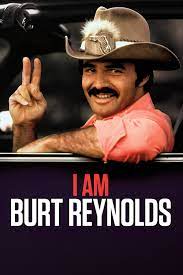
I AM BURT REYNOLDS
US, 2020, 90 minutes, Colour.
Directed by Adrian Buitenhuis.
This is one of the series of portraits of acting celebrities, 6 to 2020, all produced and directed by Adrian Buitenhuis. They generally follow a formula, providing fans with an overview of the career of the celebrity, insights into the celebrity’s background, family influences, relationships. It also highlights the personal struggles.
The device is also to have some celebrity friends as talking heads, making their observations about working with the celebrity, friendships. Wives and former wives are also prominent as well as sons and daughters.
This portrait has some very interesting talking heads, especially actors Jon Voight and Bruce Dern. Jon Voight had a long friendship with Burt Reynolds, beginning with their meeting for rehearsing and filming Deliverance. Jon Voight is very articulate, giving strong background to Burt Reynolds’ approach to Deliverance, performance, clashes, reconciliations, stunt work. And they remained friends for the succeeding decades, Voight speaking very warmly about Reynolds. Reynolds was to appear in Quentin Tarantino’s Once Upon a Time in Hollywood but was too ill and Bruce Dern took his place. Marilu Henner also appears with commentary. She had been chosen by Reynolds to appear in his television series, Evening Shade.
There are also a number of personal friends, especially those who worked on the Reynolds Ranch, code-managed by Reynolds himself and his father. There is also the director, Adam Rifkin, who wrote a screenplay, The Last Movie Star, for Reynolds who worked on it, with some excerpts shown, very much reflecting Reynolds himself in old age.
Reynolds also had celebrity in the 1970s with his nude photo in Cosmopolitan – and his rather jokey attitude towards it.
Most importantly, Reynolds’ former wife, Loni Anderson, also appears, in footage from their time together, marriage, adoption of Quinton, divorce, custody case. She is articulate in her reflections on Reynolds. There are scenes of their adopted son, Quinton, as a child, happy domestic scenes with his father, and he is also interviewed.
This gives the overall picture of Reynolds himself, his war hero father who was never warm and expressive towards son, his mother, proud and loving but, again, not warm. There is his football career, his early films and action image, the importance of Deliverance in giving him a sense of acting. Somewhat disappointing is the lack of emphasis on the wide range of romantic comedies he filmed during the 1980s. There is an emphasis on his stunt work, he was a registered stuntman, and his friendship with Hal Needham and the Smoky and the Bandit films and Hooper.
Reynolds was the top popular actor for five years. He then moved to television. He also used his ranch as an acting school for aspiring actors. He was plagued by pain, the use of painkillers, the need for rehab experiences to try to normalise his situation.
In the 1990s he was approached by Paul Thomas Anderson to appear in Boogie Nights. He refused for a long time but eventually took the role, his father rather upset, but Reynolds getting an Oscar nomination as Best Supporting Actor (Robin Williams winning for Good Will Hunting).
The I Am Series offers short portraits of celebrities, historical footage, film clips, and testimonies from friends and relatives.